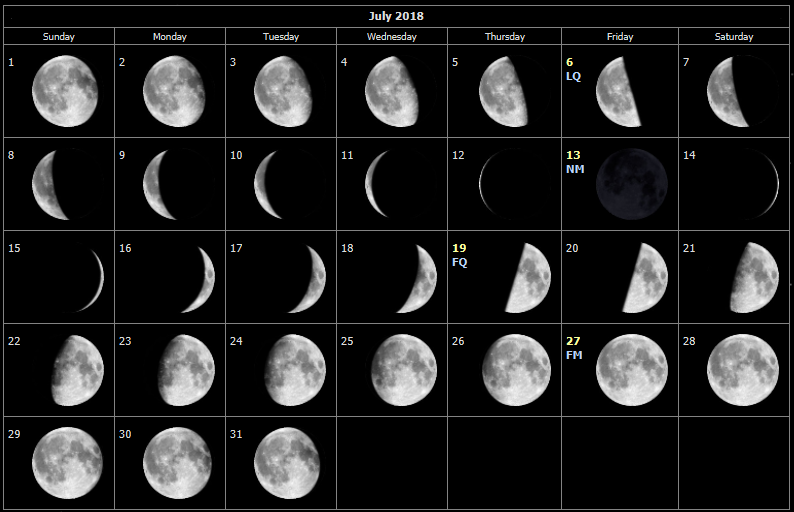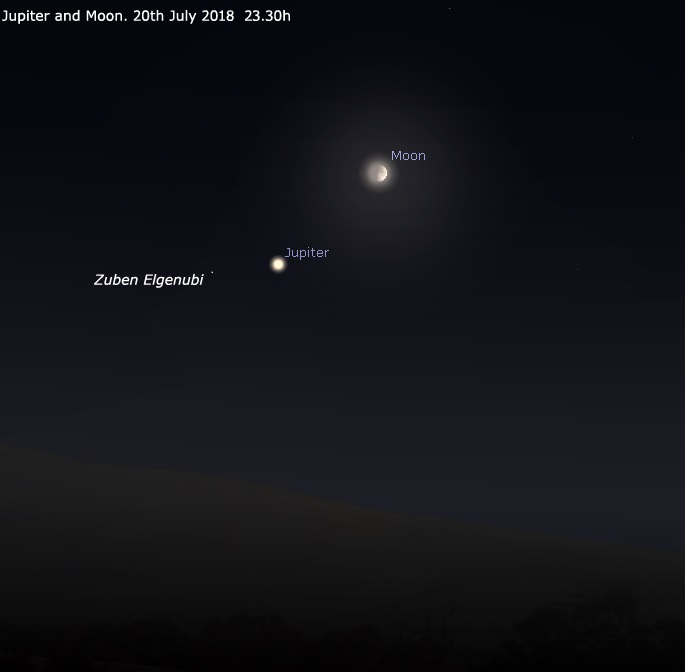In Manx skies... July 2018 ~ compiled by Dave Storey
New
13th
at
02.49h
First Quarter
19th
at
19.53h
Full
27th
at
20.22h
Last Quarter
6th
at
07.52h
Note: All times are
Universal Time (UT)
British Summer Time
is now in force. Remember to add 1 hour to any times quoted here
to get local IoM time.
There is a partial solar eclipse on 13th . Non of the eclipse is visible from the Isle of Man. Click here for details.

There
is a total lunar eclipse on the 27th
. As
seen from the IoM, the Moon rises at 20.18h (Azimuth 123°) and
will be in total shadow. This should prove a very interesting
observation! Will the Moon be visible? The Earth's shadow will
start to leave the Moon's disc at 21.13h when the Moon will be 5°
above the horizon. The umbral shadow leaves the western edge of
the Moon at 22.19h with the Moon at an altitude of 11°.
Penumbral shadow will have cleared the lunar disc by 23.28h. Click
here for more details.
Solar Aphelion occurs on the 6th
at
16.15h (152,103,776km/94,512,905miles)
Solar activity is low with solar cycle 24 now in force.
WARNING: NEVER DIRECTLY OBSERVE THE SUN WITH YOUR NAKED EYES AND/OR OPTICAL INSTRUMENTATION: YOU WILL BE BLINDED!
Carrington's Solar Rotation number 2206 starts on the 9th at 20h38m16s.
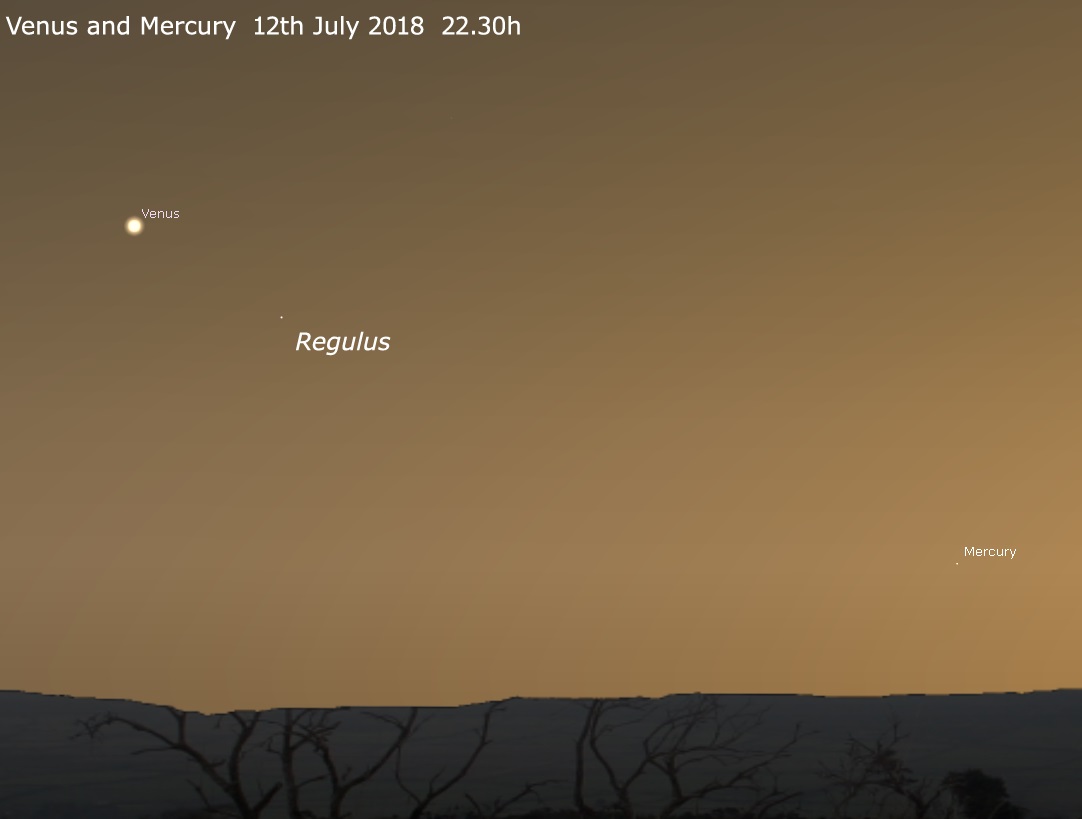
Is
visible in the evening soon after sunset during the first half of
the month. It reaches greatest eastern elongation on the 12th
when it will be 26° to the left of the Sun. The planet will be
in bright twilight and low down in Manx skies this month, so it
will be a difficult target to find.
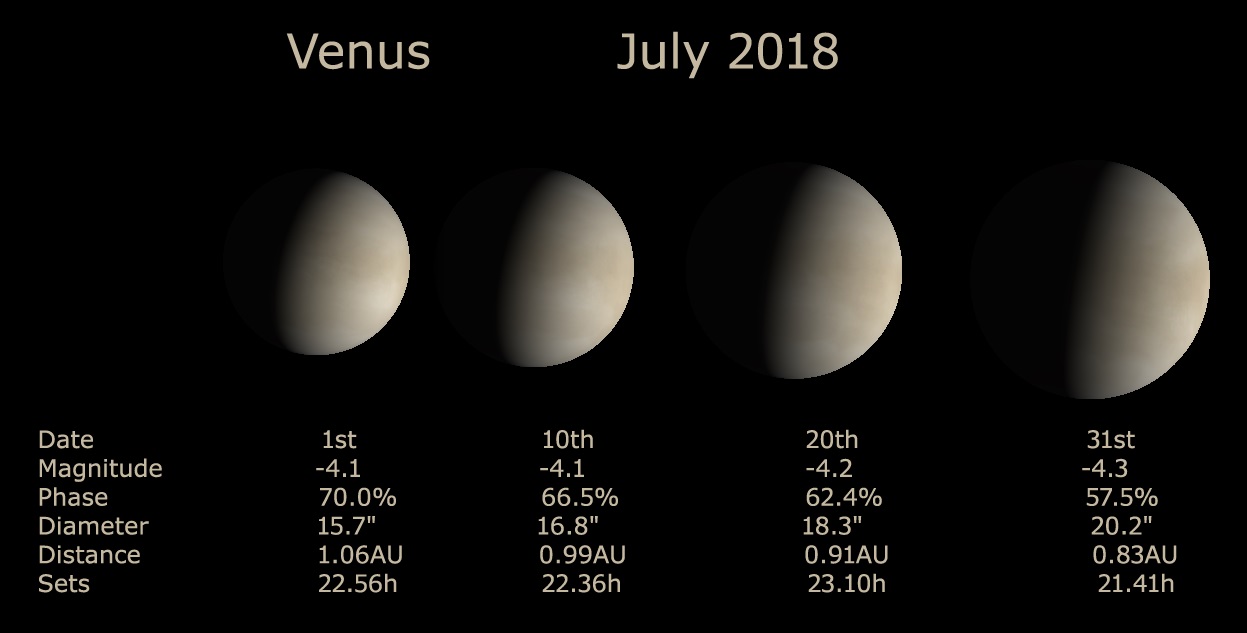
Is
found after sunset in the west shining very brightly at magnitude
-4.1 to -4.3. On the evening of the 9th,
the planet will be seen 1°
above the brightest star in Leo, Regulus. Use a pair of
binoculars to see this close appulse of planet and star. On the
evening of the 15th,
the waxing crescent Moon will be
4° to the right of Venus.
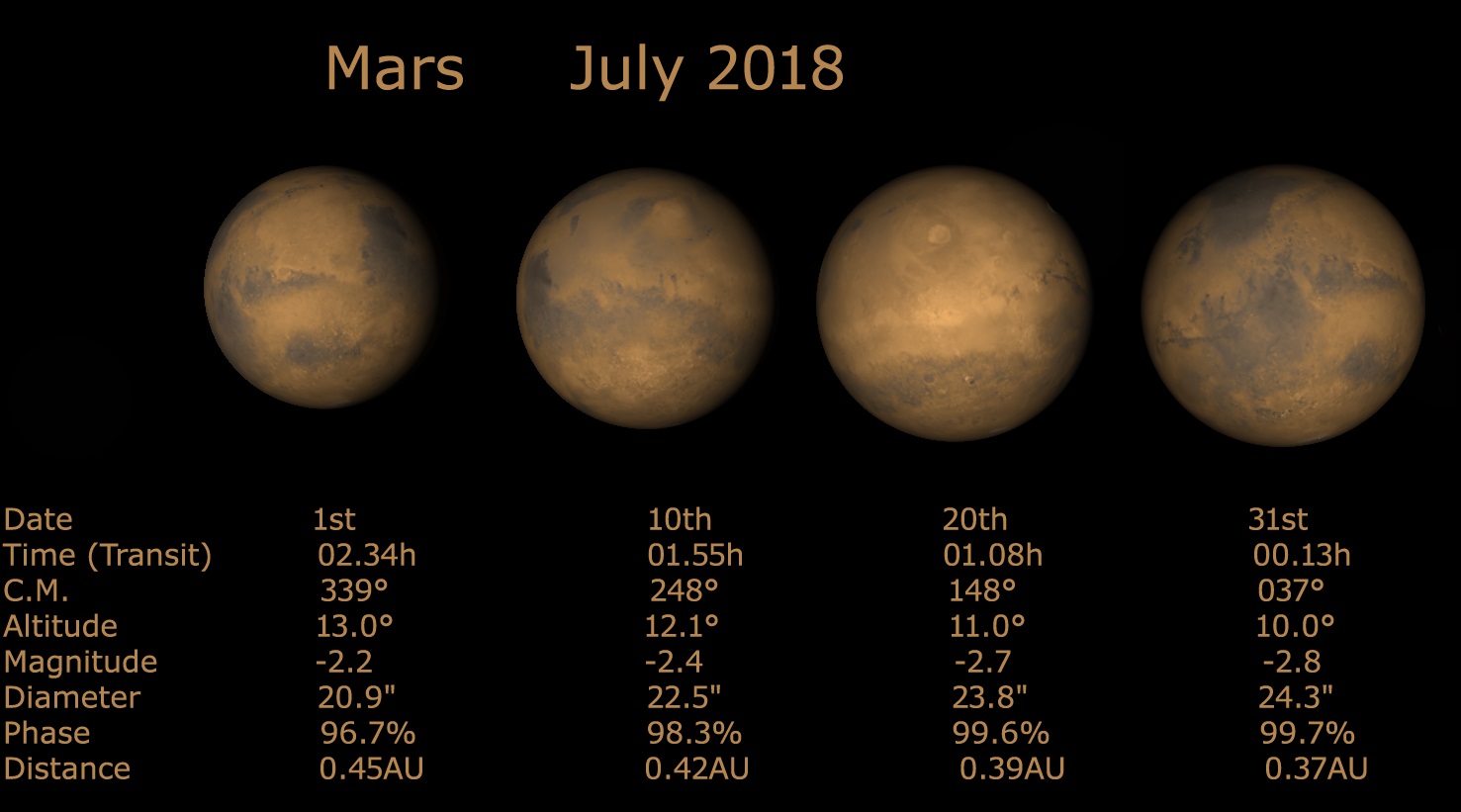
Is
at opposition on the 27th , low down in the south at
midnight in Capricornus. At this time, Mars rises at sunset and
sets at sunrise. The planet will only be 10° above the
southern horizon at best, so as seen from IoM, the telescopic view
will be somewhat degraded due to poor seeing conditions. At
opposition, the planets disc will be as wide as 24 arc seconds and
is better viewed from equatorial and southern skies. The Moon will
be 6.3° north of Mars on the night of the 27th.
Will be low down in the south
western skies after sunset, shining at magnitude -2.3 to -2.1. It
resides in the constellation Libra throughout the month and moving
in a retrograde direction (east to west) until the 11th
when it momentarily becomes
stationary before resuming a prograde (west to east) direction.
The Moon (waxing phase, 61% illuminated) will be found just over
4° upper right of Jupiter on the evening of the 20th
.
The
Great Red Spot may be seen using a telescope in good seeing
conditions. Using a light blue filter with an eyepiece will help.
Opportunities to see the Great Red Spot from Mann occur on a
regular basis. Click here for
suitable dates and times.
As
the moons orbit Jupiter, there are occasions when the shadow of
the moons can be seen upon the surface of Jupiter and the moons
can transit across Jupiter's disc. Also, the moons can be seen to
be occulted or eclipsed by Jupiter. There are many events
throughout the month. See periodicals such as the BAA
Handbook, Astronomy Now
and Sky at Night
magazines for listings.
To help you identify the moons at any particular time, Sky and Telescope have a Java tool that will plot the moon positions. Click Here.
 Can
be found very low down in the southern skies during the month,
residing in the constellation Sagittarius. It fades very slightly
from magnitude 0.0 to +0.2 during the month. The rings are well
presented towards Earth at a positive angle of 26° and should
be a nice telescopic sight, although the image being degraded by
the planets low altitude.
Can
be found very low down in the southern skies during the month,
residing in the constellation Sagittarius. It fades very slightly
from magnitude 0.0 to +0.2 during the month. The rings are well
presented towards Earth at a positive angle of 26° and should
be a nice telescopic sight, although the image being degraded by
the planets low altitude.
Titan (magnitude +8.6) will be seen west of the planet on 7th ,8th ,9th ,10th ,23rd ,24th ,25th and 26th . It will be east of the planet on 1st ,2nd ,15th ,16th ,17th and 18th .
Pluto
Is at opposition on the 12th in Sagittarius shining at a very dim +14.4, so a large telescope will be required to see the planet. The dwarf planet makes a close approach (0.4 arc minute) to the star 50 Sagittarii on the 4th and should be used as a good opportunity to track down the planet. Pluto like the rest of the planets will be low down as seen from our shores.
Use the charts below to locate the planet buy star hoping through binoculars and then a telescope. The map shown is a wide angle view of the constellation Sagittarius. The red box is the zoomed in area as shown in medium star field chart link below. And another red box within the medium star field chart will get even closer when a telescope will be required to locate Pluto. Click on narrow field star chart link for the telescopic chart.
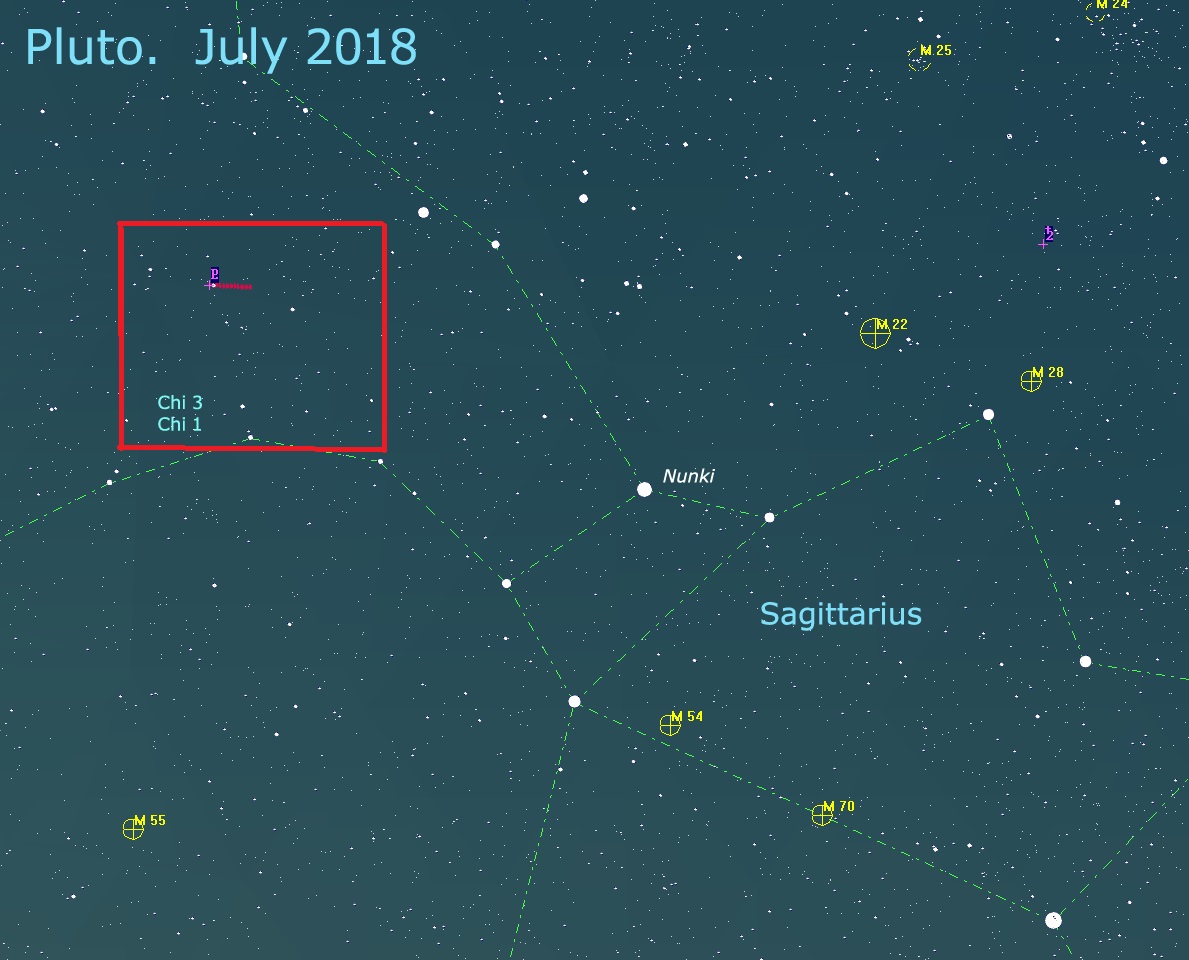
alpha-Cygnids are active during July and August with two peaks; one in July and the other in August. The peak in July occurs on the 21st July when 5 meteors per hour (ZHR) will be seen. Radiant is at RA. 21h00m Dec. +48°
Capricornids are active during July and August with three peaks this month. The dates being 9th, 16th and 26th . Like the aplha-Cygnids, the showers are weak with only 5 meteors per hour (ZHR). These meteors can display yellow-blue colours. Radiant is at RA. 20h44m Dec. -15°
delta-Aquarids are active from 15th July to 20th August. Two peaks occur, one on July 29th and another in August. The peak this month will be 20 meteors per hour (ZHR) and situated at radiant RA. 22h36m Dec. -17°. These meteors are usually faint.
Alpha-Capricornids are active from July 15th to 20th August. Peak activity occurring on the nights 2nd - 3rd August. Radiant is at RA. 20h36m Dec. -10°
iota-Aquarids can be seen during July and August with a peak due in August. This is another weak shower with only 8 meteors per hour (ZHR) at peak. Radiant is at RA. 22h10m Dec. -15°
The Perseids become active during this month and can be seen from the 23rd. Peak activity occurring in August. This shower produces some bright, fast meteors.
Date Time ZC# SAO# Magnitude. P.A. Type of event. Notes
2nd 01.48:56 3171 164560 +3.7 184° RD gamma
Cap. D*
For
very detailed list of occultations visible this month, click
here. Data from Occult Software)
Times
are UT as seen from IoMAS Observatory. Start to observe these
events about 20 minutes before the above times to allow for
differences in your latitude and longitude. This will give you
time to locate the star that is about to be occulted.
ZC
= Zodiacal Catalogue. Type of Event DD = disappearance at dark
limb, RD = Reappearance at dark limb. RB = Reappearance on bright
limb. PA = Position Angle around limb of the Moon, where 0 degrees
is north, 90 degrees is east, 180 degrees is south and 270 degrees
is west.
D* = Double Star M*=Multiple Star.
Noctilucent clouds
Noctilucent
clouds have been seen from the Isle of Man since June. Look due
north low down to the horizon to see these night time glowing
clouds. These clouds are at very high altitudes, around 80 km high
and it is this high altitude that makes them glow with sunlight
illuminating them from below the northern horizon. On
the Spaceweather.comweb
site, there is a graphic showing showing latest observations
from AIM satellite,
sent up to investigate these mysterious clouds.
This star drops from magnitude +2.1 to +3.4 in about 5 hours. There are no suitable events visible this month. Click here for a star chart for Algol.
Comet
There are no predicted bright comets this month.
The international Space Station crosses the Manx skies on a regular basis. For the latest information on when the ISS is due to pass across the sky over the next ten days, visit the link below.
Bibliography for Manx Night Skies
The
Handbook of the British Astronomical Association 2018. BAA.
2017
2018 Stargazing. Heather Couper & Nigel Henbest.
Philip's 2017
2018 Guide to the Night Sky. Storm Dunlop &
Wil Tirion. Collins 2017
Yearbook of Astronomy 2018. Brian
Jones/Richard Pearson. Pen & Sword White Owl. 2017
Observer's
Handbook Meteors. Neil Bone. Philip's 1993
Atlas of the Night
Sky. Storm Dunlop. Collins. 2005
Constellations. Josef Klepešta
and Antonin Rükl. Hamlyn. 1979
Brilliant Stars. Patrick
Moore. The Book People Ltd. 1996
Complete Guide to Stargazing.
Robin Scagell. Phillip's. 2006
Turn Left at Orion. Guy
Consolmango and Dan M. Davis. Cambridge U.P. 2008
Norton's
2000.0 Edited Ian Ridpath. Longman Scientific & Technical.
1989
Planetary data derived from
Guide 9
Software.
Picture graphics derived from Stellarium
and Guide 9 Software.

